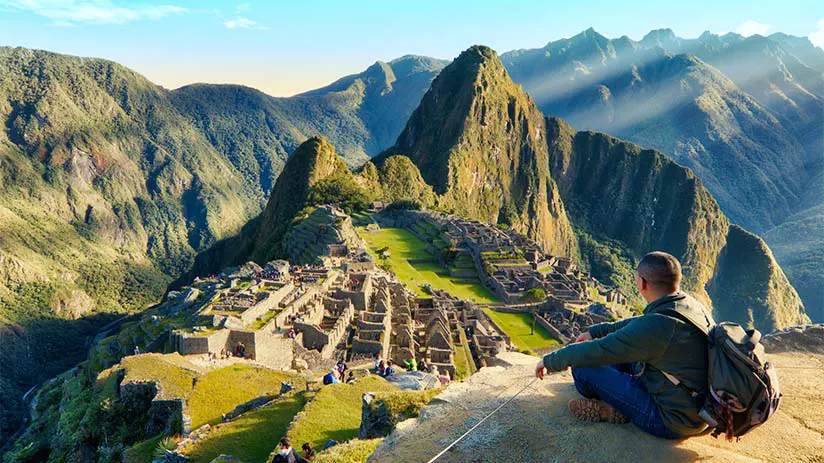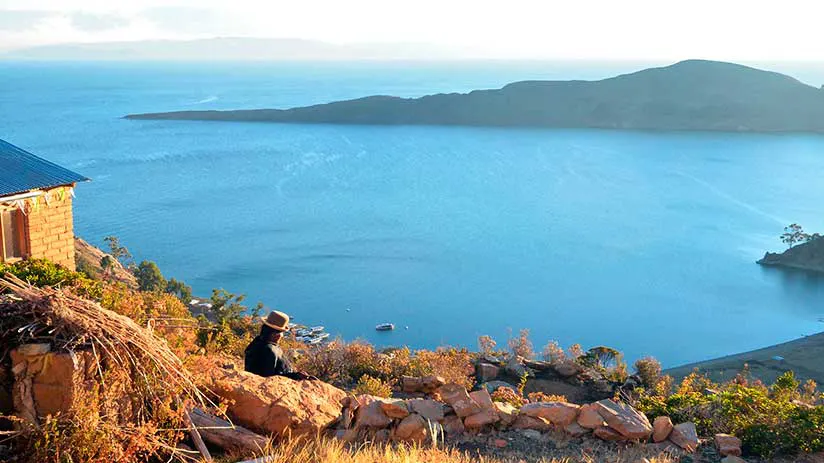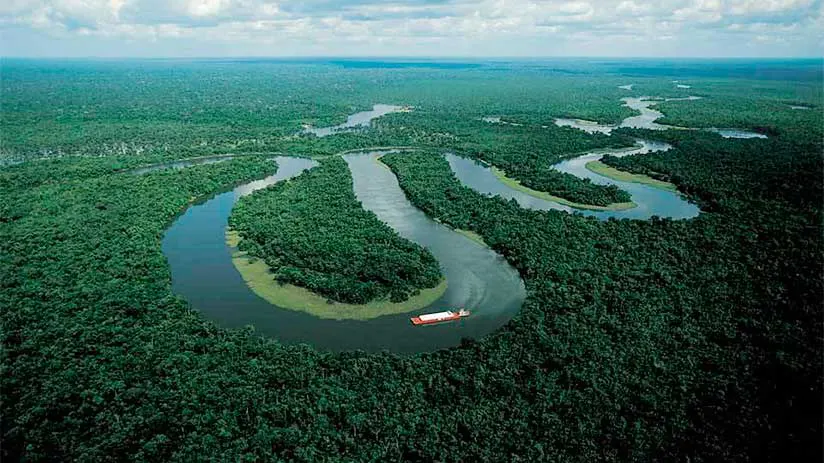Peru is famous for its amazing Amazon rainforest, rich history, and enduring traditions. Penguins that prefer rocks to ice, or the oldest university in America. Also, Peru is the world climate synthesis, among other facts about Peru, making this a unique universe to discover.
And with so much to offer, it’s common for some things to go unnoticed while others stand out. With Machu Travel Peru, we want to share unknown facts about Peru to make this country more well-known and appreciated for its beauty.
18 most interesting facts about Peru
- It has Machu Picchu
- The territory of a great empire of the Incas
- Mysterious Nazca Lines
- Caral is the oldest American city
- San Marcos is the oldest American university
- Cradle of Surf
- Punk music was born in Peru
- Colca is one of the world’s deepest canyon
- Titicaca is the highest navigable lake in the world
- The origin of the Amazon River
- It has rainbow mountains
- Renowned gastronomy
- Cradle of Potatoe
- Guinea pigs are food, not pets
- Penguins that prefer rocks over ice
- Endemic Peruvian naked dog
- Climate Synthesis of the World
- More than one official language
Overview

| Official name | Republic of Peru |
| Location | Peru is in central-western South America. It is limited by the north, with Ecuador and Colombia. By the east with Brazil and by the southeast with Bolivia. By the south with Chile and west with the Pacific Ocean |
| Area | 1,285 246 square kilometers (496 224 square miles) |
| Population | 33.7 million inhabitants (2022 census) |
| Capital | Lima (10.8 million inhabitants) |
| Type of government | Presidential republic |
| Language | Spanish, and native languages Quechua and Aymara |
| Religion | 76% Catholic, 14.1% Evangelicals, 9.9% other religions |
| Money | S/ Nuevo Sol (New Sun) / $1 USD = 3.80 S/ approx |
| Time zone | 5 hours behind Greenwich Mean Time |
| Telephone country code | +51 |
1. It has Machu Picchu

First, What is Machu Picchu? Well, it was a ceremonial quarter and a resting place for the Panaca of Inca Pachacutec. The panaca was the family and relatives of an Inca regent.
It’s 8,000 feet above sea level in the jungle eyebrow of Cusco. The extreme west of Sacred Valley.
Among Machu Picchu facts, the Spanish conquistadors never reached it despite knowing of its existence. Thus, it was never dismantled and remained intact until 1902. Date in which Cuzquenean farmer Agustin Lizarraga discovered it.
And made known to the world in 1911 by the American explorer Hiram Bingham. Becoming the lost city of the Incas in the most famous attraction in Peru.
2. The territory of a great empire, the Incas

The Incas were one of the world’s largest empires. Its first integrants came from the Peruvian plateau (South of the country, today, border with Bolivia).
They ruled for more than 300 years in the South American Sierra. Having the capital of the Inca empire in Cusco. At the height of its domain, scholars consider it one of the largest empires worldwide!
Covering modern territories of Ecuador, Bolivia, Peru, Argentina, and Chile. Its extension is even compared to that of the Roman Empire!
3. Mysterious Nazca lines

These are a collection of more than 70 giant glyphs, and some lines extend to 30 miles long. These are between the Nazca and Palpa deserts (the south region of Lima).
But how were the Nazca Lines made? Theories about its function and origin abound. And some of them can be explained around fantastic themes such as landing strips or road signs for aliens.
However, the most accepted theory is that it was a gigantic agricultural calendar made by the Nazca culture.
4. Caral is the oldest American city

In 1997, Peruvian archaeologist Ruth Shady found the oldest city in America.
The Caral city has around 5000 años of built. Its creators, the Caral civilization, lived around 3000 – 1800 B.C., 174 km north of Lima. So, Caral is contemporary to the world’s original civilizations (which did not derive from others). We can mention Egypt, India, Sumeria, and China!
These original civilizations had contacts and commerce among them, but Caral did not. Therefore, Caral people developed themselves and became isolated from the world.
5. San Marcos is the oldest American university

Neither Harvard, Yale, nor Stanford is the oldest university in America; San Marcos University in Lima has this honor. Spanish King Carlos I founded the university on May 12, 1551, through a Royal Certificate.
In this way, San Marcos became the oldest functioning university in America. Initially, the Dominican order managed it, but today, it has its own administrative board. Four schools form it:
- Colegio Real y Mayor de San Martín
- Colegio Real y Mayor de San Felipe y San Marcos
- Real Colegio de San Carlos (focused on law and letters, derived from the merger of the two previous ones)
- Real Colegio de San Fernando (focused on medicine and surgery)
6. Cradle of Surf

Peru is believed to have been the cradle of surfing in the small coastal town of Huanchaco, north of Peru. There, local fishermen still ride on Caballitos de Totora (Totora’s horses) as their ancestors did three thousand years ago.
Caballitos de Totora are artisanal rafts, similar to kayaks, with a pointed prow made from Totora, a native reed. Some even stand on them, sliding over waves, as if they were surfing.
The earliest evidence that surfing started in Peru comes from Mochica ceramics, around 200 AD. In these ceramics, anyone can appreciate persons trying to overcome a wave on Totora boards.
Therefore, surfing can be a great option if you are looking for things to do in Peru.
7. Punk music was born in Peru

The general knowledge affirms that the Punk movement, clothes, mindsets, and lifestyle, were born in England, in the late 1970s. Except in one subject: music. Punk music was born in Lima – Peru, 6,356 miles from London, in 1964.
There, a group of young people gathered in the garage of the vocalist to make noise. None of them knew how to play. They only had two guitars, a bass, and a drum kit, a great desire to feel like rockstars.
So, they started playing their own songs in Lima theaters. They only recorded six singles and never recorded a complete album. Finally, they dissolved, like the Sex Pistols, between 1965 and 1966. Years later, a Spanish radio show found them in 1998 and reunited them to make an album in 2006.
In this way, Los Saicos were born, died, and resurrected. The pioneer band of punk around the world.
8. Colca is one of the world’s deepest canyon

Peru has two canyons competing among the deepest in the world. The Cotahuasi Canyon (3535 meters deep) and the Colca Canyon (4160 meters deep). Both are in Arequipa, south of Peru. And are two of the most incredible landscapes of the Andean country.
Both are twice as deep as the well-known Grand Canyon of the United States (2422 meters deep). Making them an essential part of tourism in Peru. There are numerous tours to enjoy hiking or luxurious hotels in its surroundings. Which, combined with the dreamy views, make it one of the best destinations available in Peru.
9. Titicaca is the highest navigable lake in the world

Peru boasts the highest navigable lake in the world. The Lake Titicaca is over 3812 meters above sea level and has 8562 square kilometers. It is accessible from the route through Cusco and/or Arequipa, as well as Puno. The last city hosts the lake.
It has become in recent years a trendy destination due to the Uros islands. These are floating islands made entirely from totora reeds that you can explore and visit!
The Lake is also home to countless alternative cultures that continue to practice ancient traditions. We can mention the inhabitants of the islands of Sillustani and Taquile. So, if you want to know more about history, traditions, and native lifestyle, we recommend visiting Peru in June. This is the dry season, with more sun rays, clear skies, and cold breezes, to combine the landscapes with other wonderful festivities.
10. The origin of the Amazon river

Did you know the source of the Amazon River is in Peru? Yes, you read it correctly. This renowned river that runs through several South American countries begins in the Peruvian Andes mountains.
Specifically, Amazon has its origin very close to Machu Picchu, in the Chila mountain range. Its cradle is in the foothills of the snowy Mismi, south of Peru. And it flows to the other side of the continent, on Brazil’s coasts, into the Atlantic Ocean.
The Amazon in Peru makes up 60% of the Andean region. It is home to incredible wildlife. One notable species is the Gallitos de las Rocas, which is Peru’s national animal.
This makes Peru an Amazon territory and not an Andean one. If you want to visit Peru, don’t overlook this fact. The Peruvian Amazon is a place that you must not lose.
11. It has rainbow mountains

Argentina, China, and the United States have rainbow mountains, but Peru’s are the most colorful. The soil in the Peruvian highlands is full of minerals. The climate there is cold and dry. This combination makes the colors of the hills bright and clear.
And, if you wanted to guess, well, you are right, these mountains are in the same department as Machu Picchu, Cusco. Therefore, the Rainbow Mountains in Peru are the second most visited attraction, just behind Machu Picchu tours. Vinincunca is the name of the first mountain over 5,200 meters above sea level. Palcoyo is the second mountain at 4,900 meters above sea level.
12. Renowned gastronomy

In the 2000s, when Latin America began to revalue its native ingredients and products for its regional cuisines, Lima was the epicenter of the gastronomic revolution in the region. The Incas in Peru used Andean ingredients and old cooking methods to make new dishes. They built on their culinary tradition in the cradle of ancestral culture. Therefore, everybody knows Peru for its gastronomy.
Nowadays, Lima is the city where you can enjoy several distinguished restaurants. Many of them are in the top ten of the prestigious list of “The World 50 Best” organizations.
Dishes such as the Peruvian ceviche, Cuy, or Lomo Saltado are iconic examples. There are also other unique variations throughout the country. In addition, you can also experience numerous traditional Peruvian drinks to accompany your plates, like the Peruvian Pisco. It also offers distinguished non-alcoholic drinks to enjoy on a cold night.
13. Cradle of Potatoe

Are you a fan of French Fries? Or just from Potatoes? Then you should know that Peru is the cradle of the Potatoe. Peru is home to some 4,000 varieties of potatoes, an inevitable ingredient in most of its gastronomy.
Around 8,000 years ago, Peruvians domesticated and cultivated this tuber in south Peru for the first time.
The potato saved Europe from famine in the 19th century and became a staple food in kitchens across the region. Therefore, it is one of the main ingredients in various Peruvian dishes. In Peruvian markets, you can find 12 types of potatoes for sale, used for frying, boiling, or cooking. Therefore, in Cusco, you will find many typical dishes in which the potato is the protagonist.
14. Guinea pigs are food, not pets

If you are traveling alone in Peru, be sure to visit the different important gastronomic festivals. At many of these, you will see a dish served quite often. We refer to Cuy Asado (Roasted Guinea Pig). This is a traditional dish with a guinea pig as the main ingredient.
The Cusco people serve this animal crisp and complete with its head, legs, and eyes, accompanied by potato boiled and stuffed red pepper.
Cuy is a traditional and important Peruvian food in the Andean regions of Peru. It is one of the many interesting facts about Peru.
The dish is rich in protein and is usually quite healthy. Besides, the Incas have consumed it since immemorial times. This is a great option to experience something new if you have the courage.
15. Penguins that prefer rocks over ice

You can see penguins not only in Antarctica but also at the North Pole. Peru has a special group of islets of dry sand and rocks that are home to a quaint penguin species. The Ballestas Islands.
The Humbolt penguin. But How do these penguins appear in this particular zone? Well, the Humboldt Current is an outcrop of deep and cold waters of the Antarctic Sea that runs from south to north.
The further north, these waters get warmer. Penguins swim along this nutrient-rich current from Antarctica to the Ballestas Islands in Peru.
In this sense, seeing the penguins in Ballestas islands is one of the best things to do in Paracas. It is a fixed point that you cannot miss on your vacation in Peru.
16. Endemic Peruvian naked dog

Foreign people know this quaint animal as naked; the Peruvians call it the Peruvian dog. This hairless dog breed is both cute and ugly, both at the same time.
Their body is completely naked and hairless, often covered in spots. While on the top of their head and back, they have a small tuft of gray or white hair. These characteristics make him look like an elderly dog, but one of the fun ones. It is a breed that usually lives for more than ten years and weighs approximately 20 pounds.
Recent researches affirm that the warmth of their skin can relieve rheumatic pain in the hands and feet of human beings. The person just has to put his skin in contact with the dog’s for a long time, and well done!
17. Climate Synthesis of the World

The Peruvian landscape is diverse. It includes humid jungles in the Amazon, dry deserts in the south, and cold mountains. The journey ends at beautiful beaches in the north and charming towns in the Central Sierra.
Well, meteorologists catalog Peru as the climactic synthesis of the world because it has impressive climatic diversity. Also, Peru is the third largest country in South America after Brazil and Argentina. In other words, In other words, it has all the climates ofall countries the world.
Arid and temperate on the coast and Peru beaches, rainy and cold in the mountains, and very rainy and hot in the jungle. These are examples of how the climate in Peru can be a real surprise for an amateur tourist.
18. More than one official language

As is common knowledge, Andean countries have great cultural diversity. The clothing and food, reflect this fact, but the languages in Peru deserve a special mention. If you are living in Peru, you’ll realize that it is home to 3 official languages.
83% of the Peruvian population speaks Spanish, but it is not the only language. In the Andes and Peru‘s plateau, people speak two main languages. One is Quechua, the ancient language of the Incas. The other is Aymara, a traditional language used in Peru and Bolivia.
Besides them, there are many other indigenous languages spoken along the Amazon rainforest. Each one belongs to different Amazon tribes and communities.
“GOING TO PERU IS… WELL, IF YOU EVER HAVE AN OPPORTUNITY IN YOUR LIFE TO GO THERE, YOU SHOULD DO IT BECAUSE IT IS ABSOLUTELY MIND-BOGGLING”
With Machu Travel Peru, we wanted to highlight the unique aspects of Peru that make it a special destination. This beautiful country has more to offer than archaeological sites. There are many other things to learn. There are also many things to explore.
If you want to learn about Andean life, you can talk to our advisors for free. They know a lot about the beauty of the Andes. We will be waiting for your soon visit to the beautiful Andean country!
